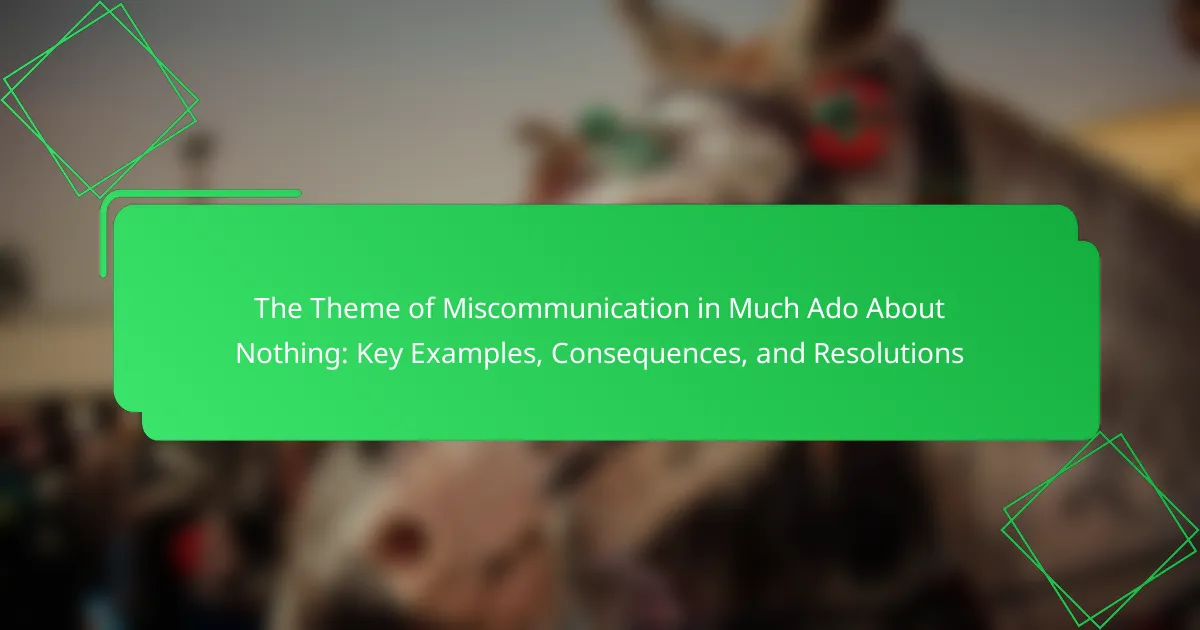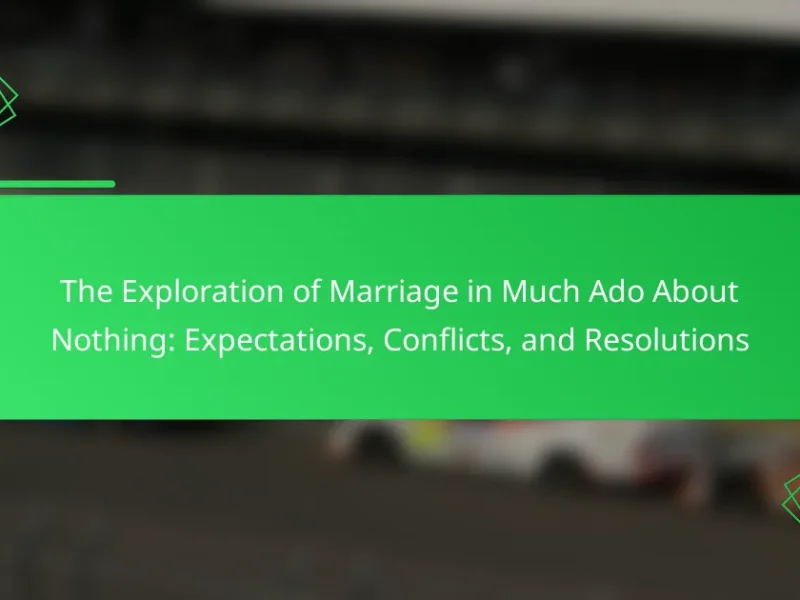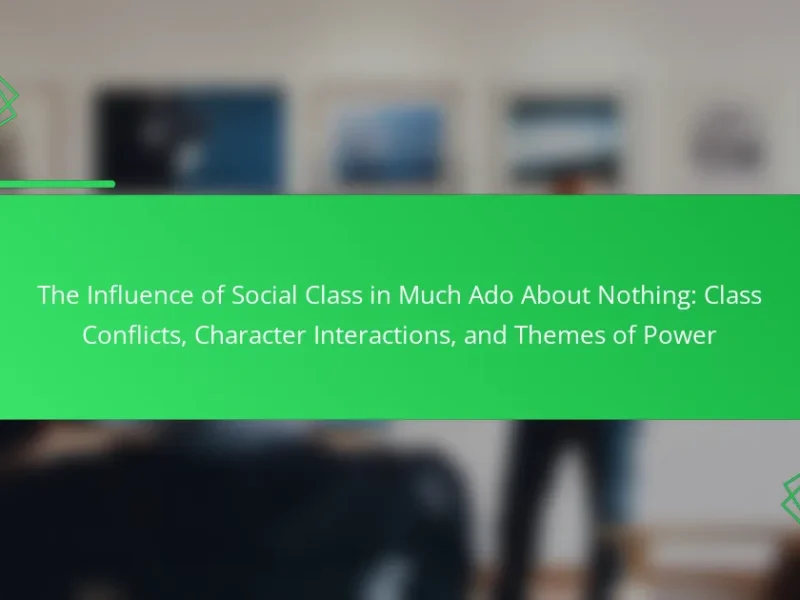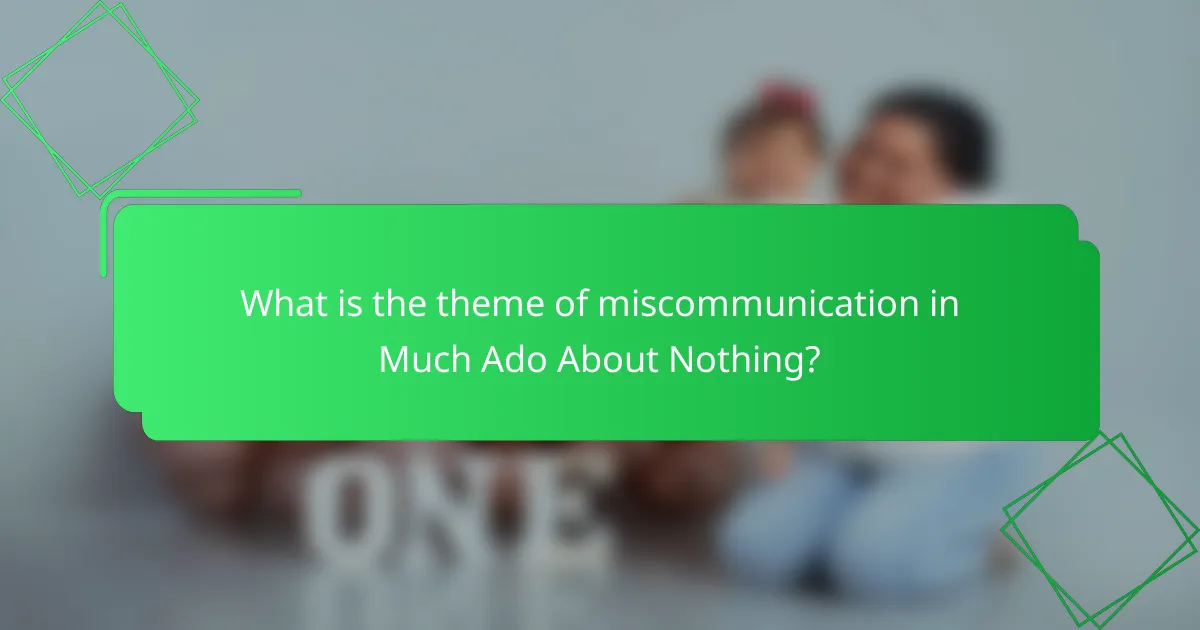
What is the theme of miscommunication in Much Ado About Nothing?
The theme of miscommunication in Much Ado About Nothing is central to the plot and character development. Misunderstandings drive the narrative and create conflict among characters. For instance, Claudio misinterprets Don John’s deception, leading him to shame Hero publicly. Additionally, Beatrice and Benedick engage in witty banter that obscures their true feelings for each other. The miscommunication also extends to the mistaken identity and eavesdropping prevalent in the play. These elements highlight how easily words can be misconstrued. Ultimately, the resolution of these misunderstandings leads to reconciliation and the restoration of relationships. This theme emphasizes the importance of clear communication and the consequences of assumptions.
How does miscommunication manifest in the play?
Miscommunication in Much Ado About Nothing manifests through misunderstandings and deception. Characters often misinterpret intentions and words. For example, Claudio misjudges Hero’s fidelity based on misleading reports. This leads to public shaming and conflict. Additionally, the masked ball creates confusion about identities. Benedick and Beatrice’s witty banter often obscures their true feelings. Such instances highlight the play’s exploration of how miscommunication can disrupt relationships. Ultimately, these misunderstandings drive the plot and character development.
What are the key instances of miscommunication between characters?
Key instances of miscommunication between characters in Much Ado About Nothing include the misunderstanding between Claudio and Hero. Claudio believes Hero is unfaithful based on false information from Don John. This leads to Claudio publicly shaming Hero at their wedding. Another instance occurs when Benedick and Beatrice overhear conversations about each other’s feelings, leading to confusion and misinterpretation of intentions. Additionally, the mix-up regarding the identity of Borachio creates further complications. These miscommunications drive the plot and highlight themes of trust and deception.
How do misunderstandings shape character relationships?
Misunderstandings significantly shape character relationships by creating conflict and tension. In “Much Ado About Nothing,” misunderstandings lead to pivotal moments that alter relationships. For example, Claudio’s misinterpretation of Hero’s fidelity results in public humiliation and a rift in their relationship. Similarly, Benedick and Beatrice’s initial misunderstandings fuel their witty banter and eventual romance. These conflicts often stem from deceptive appearances and misinformation, showcasing how communication failures can distort perceptions. The resolution of these misunderstandings, through clarification and dialogue, ultimately strengthens relationships. This dynamic illustrates the theme of miscommunication and its profound impact on interpersonal connections in the play.
Why is miscommunication significant to the plot of Much Ado About Nothing?
Miscommunication is significant to the plot of Much Ado About Nothing because it drives the central conflicts and resolutions. Characters misunderstand each other’s intentions, leading to false accusations and emotional turmoil. For example, Claudio misinterprets Don John’s deception as infidelity, causing him to publicly shame Hero. This pivotal moment showcases how miscommunication can disrupt relationships and create chaos. Additionally, Benedick and Beatrice’s witty banter often masks their true feelings, revealing deeper misunderstandings. Ultimately, the resolution of these miscommunications leads to reconciliation and growth among the characters. Thus, miscommunication serves as a catalyst for both conflict and resolution in the narrative.
What role does miscommunication play in the development of the story?
Miscommunication serves as a driving force in the development of the story. It creates misunderstandings that propel the plot forward. For instance, Claudio’s misinterpretation of Don John’s deception leads to a public shaming of Hero. This pivotal moment escalates conflict and tension among the characters. Additionally, the mistaken identities and eavesdropping contribute to the comedic elements of the narrative. The characters’ failures to communicate effectively highlight themes of trust and betrayal. Ultimately, miscommunication shapes relationships and influences character arcs throughout the play.
How does miscommunication contribute to the themes of love and deception?
Miscommunication significantly contributes to the themes of love and deception in “Much Ado About Nothing.” Characters often misunderstand each other’s intentions, leading to conflict and emotional turmoil. For example, Claudio misinterprets Don John’s deceitful manipulation as truth, resulting in his public shaming of Hero. This act of deception stems from a lack of clear communication between characters. Additionally, misunderstandings between Benedick and Beatrice create comedic tension while simultaneously showcasing the complexities of love. The play illustrates how miscommunication can distort reality, leading to false perceptions and actions. Thus, miscommunication serves as a catalyst for both romantic and deceptive themes throughout the narrative.
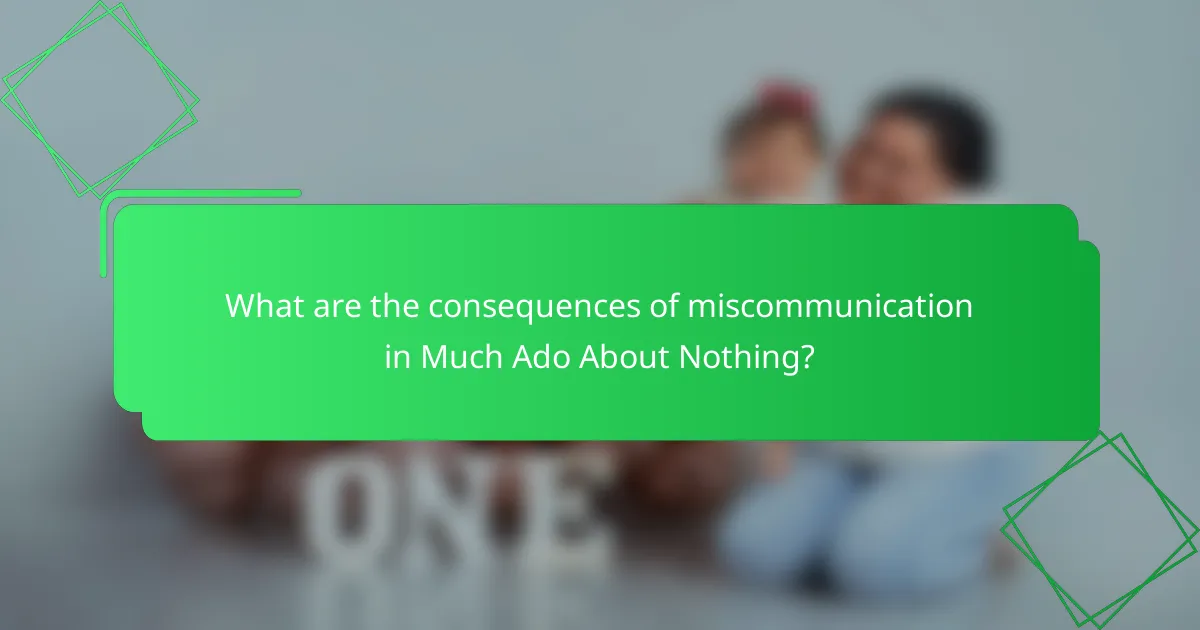
What are the consequences of miscommunication in Much Ado About Nothing?
Miscommunication in Much Ado About Nothing leads to misunderstandings, conflicts, and emotional turmoil. For instance, Claudio’s misinterpretation of Hero’s fidelity results in public humiliation at their wedding. This act causes Hero to faint and be presumed dead, demonstrating the severe emotional consequences of miscommunication. Additionally, the deception surrounding Beatrice and Benedick’s feelings creates tension and confusion among friends. Miscommunication also fuels the villainous actions of Don John, who exploits misunderstandings to create chaos. Ultimately, the resolution of these miscommunications is essential for reconciliation and the restoration of relationships by the end of the play.
How does miscommunication lead to conflict among characters?
Miscommunication leads to conflict among characters by creating misunderstandings and false assumptions. In “Much Ado About Nothing,” characters often misinterpret each other’s words and intentions. For example, Claudio misreads Don John’s deception as genuine betrayal. This miscommunication results in Claudio publicly shaming Hero at their wedding. Additionally, misunderstandings arise from eavesdropping and gossip, such as when Beatrice overhears a conversation and misinterprets it. These instances of miscommunication escalate tensions and create divisions among characters. Ultimately, these conflicts highlight the destructive impact of poor communication in relationships.
What specific events are triggered by misunderstandings?
Misunderstandings in “Much Ado About Nothing” trigger several specific events. One event is the false accusation against Hero, leading to her public shaming. This misunderstanding occurs when Claudio misinterprets Don John’s deceitful information. Another event is Benedick and Beatrice’s miscommunication about each other’s feelings, causing unnecessary conflict. Additionally, the misunderstanding between Don Pedro and Claudio regarding Hero’s fidelity catalyzes the plot’s climax. These events demonstrate how miscommunication can lead to significant emotional turmoil and conflict among characters.
How do these conflicts affect the overall narrative?
Conflicts in “Much Ado About Nothing” significantly shape the overall narrative. They create tension and drive the plot forward. Miscommunication leads to misunderstandings among characters. These misunderstandings often result in conflict, such as the false accusations against Hero. The conflicts reveal character flaws and societal issues. They also highlight the theme of deception, both intentional and accidental. Ultimately, the resolution of these conflicts restores harmony and reinforces the story’s moral lessons. The narrative arc is thus defined by the interplay of conflict and resolution, showcasing the consequences of miscommunication.
What emotional impacts does miscommunication have on the characters?
Miscommunication leads to feelings of betrayal and mistrust among the characters. In “Much Ado About Nothing,” misunderstandings create rifts in relationships. For example, Claudio’s misinterpretation of Hero’s fidelity results in public humiliation for Hero. This incident causes Hero deep emotional distress and leads to her apparent death. Similarly, Beatrice and Benedick experience confusion about each other’s feelings, which delays their romantic connection. The emotional turmoil caused by these miscommunications ultimately drives the plot and highlights the theme of misunderstanding. The characters’ responses to miscommunication reveal their vulnerabilities and the fragility of trust in relationships.
How do characters respond to being miscommunicated with?
Characters respond to being miscommunicated with through confusion, anger, or humor. Confusion arises when characters misunderstand intentions or meanings. For example, when Benedick overhears a conversation, he misinterprets it, leading to misguided actions. Anger can manifest when characters feel wronged due to miscommunication. Claudio’s reaction to Hero’s supposed infidelity exemplifies this, causing public humiliation. Humor often serves as a coping mechanism, as seen in the banter between Beatrice and Benedick. These varied responses highlight the emotional impact of miscommunication. Miscommunication drives the plot and character development in “Much Ado About Nothing.”
What are the implications of these emotional responses on their actions?
Emotional responses significantly influence characters’ actions in Much Ado About Nothing. For instance, jealousy prompts Claudio to publicly shame Hero. This act stems from his emotional turmoil and miscommunication regarding her fidelity. Similarly, Beatrice’s feelings for Benedick lead her to challenge societal norms. Her emotions drive her to confront her own vulnerabilities. Additionally, misunderstandings fueled by emotions cause conflicts between characters. These emotional responses often result in hasty decisions that escalate tensions. Ultimately, emotions shape the narrative, highlighting the consequences of miscommunication.
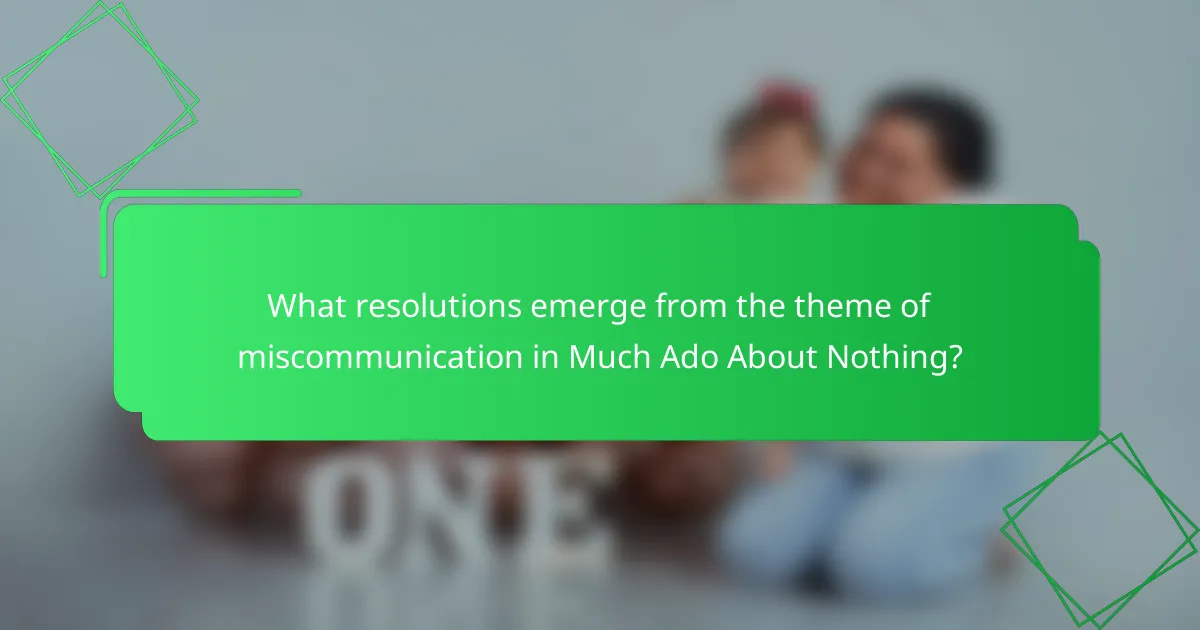
What resolutions emerge from the theme of miscommunication in Much Ado About Nothing?
The resolutions that emerge from the theme of miscommunication in Much Ado About Nothing include reconciliation and clarity in relationships. Characters such as Claudio and Hero ultimately resolve their misunderstandings through open dialogue. Claudio’s initial belief in Hero’s infidelity leads to public shaming. However, after learning the truth, he seeks forgiveness. Benedick and Beatrice also confront their miscommunications, leading to a mutual understanding of their feelings. The play resolves with multiple marriages, symbolizing restored harmony. These outcomes highlight the importance of communication in overcoming misunderstandings.
How do characters resolve misunderstandings throughout the play?
Characters resolve misunderstandings in Much Ado About Nothing through dialogue and confrontation. For instance, Beatrice and Benedick clarify their feelings after overhearing conversations. Claudio and Hero’s misunderstanding is resolved when Hero’s innocence is revealed. The use of deception, such as the masked ball, also plays a critical role in miscommunication. Ultimately, misunderstandings are addressed through honest communication and reconciliation among characters. The resolution often leads to renewed relationships and understanding.
What specific actions lead to the clarification of miscommunications?
Specific actions that lead to the clarification of miscommunications include active listening, asking questions, and summarizing information. Active listening ensures that all parties understand each other’s perspectives. Asking questions helps clarify any uncertainties or ambiguities in the conversation. Summarizing information allows individuals to confirm their understanding and correct any misconceptions. These actions foster open dialogue and enhance comprehension. Research indicates that effective communication strategies significantly reduce misunderstandings in interpersonal interactions.
How do these resolutions contribute to character growth?
Resolutions in Much Ado About Nothing enhance character growth by promoting self-awareness and personal development. Characters confront misunderstandings and their consequences. This confrontation leads to reflection on their actions and beliefs. For instance, Benedick and Beatrice evolve through their resolved miscommunications. Their initial misunderstandings transform into deeper understanding and love. Additionally, Claudio’s resolution to publicly shame Hero prompts him to recognize his mistakes. This recognition fosters his growth and eventual redemption. Thus, resolutions serve as pivotal moments for characters to learn and evolve.
What lessons can be learned from the theme of miscommunication in Much Ado About Nothing?
Miscommunication in Much Ado About Nothing teaches the importance of clear communication. Characters often jump to conclusions based on misunderstandings. For instance, Claudio wrongly believes that Hero has been unfaithful. This leads to public humiliation and conflict. The play illustrates how rumors can distort perceptions. It shows that assumptions can have dire consequences. Ultimately, the resolution emphasizes the need for dialogue and honesty. Miscommunication can be resolved through understanding and reconciliation.
How can the insights gained from the play be applied to real-life communication?
Insights from the play can enhance real-life communication by highlighting the importance of clarity. Miscommunication often arises from assumptions and lack of direct dialogue. For instance, characters in Much Ado About Nothing face misunderstandings due to vague language. This illustrates the need for explicit expressions of thoughts and feelings. Active listening is also vital, as demonstrated by characters who misinterpret intentions. Applying these insights encourages individuals to engage in open discussions. Additionally, the play shows that addressing conflicts directly can prevent escalation. Overall, these lessons promote healthier communication dynamics in personal and professional relationships.
What strategies can help prevent miscommunication in relationships?
Active listening is a key strategy to prevent miscommunication in relationships. It involves fully concentrating on the speaker, understanding their message, and responding thoughtfully. This practice fosters clarity and ensures both parties feel heard.
Additionally, using clear and concise language minimizes misunderstandings. Avoiding jargon or ambiguous terms helps convey messages more effectively.
Regular check-ins between partners can also enhance communication. These discussions allow for feedback and clarification of any potential misunderstandings.
Non-verbal cues should not be overlooked. Body language, [censured] expressions, and tone of voice play significant roles in how messages are interpreted.
Establishing a safe space for open dialogue encourages honesty. When partners feel secure, they are more likely to express their thoughts and feelings.
Lastly, summarizing key points during conversations can reinforce understanding. This technique ensures both individuals are on the same page and reduces the likelihood of misinterpretation.
The main entity of the article is the theme of miscommunication in Shakespeare’s play Much Ado About Nothing. The article examines how miscommunication drives the plot, creates conflict, and shapes character relationships through key examples, such as Claudio’s misunderstanding of Hero’s fidelity and the witty banter between Benedick and Beatrice. It explores the consequences of these misunderstandings, including emotional turmoil and public humiliation, while also highlighting the resolutions that emerge through dialogue and reconciliation. Ultimately, the article emphasizes the importance of clear communication and the lessons that can be applied to real-life interactions.
